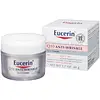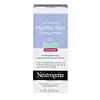What's inside
What's inside
 Key Ingredients
Key Ingredients

 Benefits
Benefits

 Concerns
Concerns

 Ingredients Side-by-side
Ingredients Side-by-side

Ethylhexyl Methoxycinnamate 7.5%
UV AbsorberEthylhexyl Salicylate 3%
UV AbsorberBenzophenone-3 3%
UV AbsorberWater
Skin ConditioningGlycerin
HumectantCyclomethicone
EmollientCetyl Alcohol
EmollientMethylpropanediol
SolventAlcohol Denat.
AntimicrobialCetearyl Isononanoate
EmollientGlyceryl Stearate Se
EmulsifyingPalmitic Acid
EmollientStearic Acid
CleansingUbiquinone
AntioxidantPanthenol
Skin ConditioningTocopheryl Acetate
AntioxidantCaprylic/Capric Triglyceride
MaskingOctyldodecanol
EmollientPhenoxyethanol
PreservativeEthylhexylglycerin
Skin ConditioningPiroctone Olamine
PreservativeCarbomer
Emulsion StabilisingSodium Hydroxide
BufferingDisodium EDTA
Ethylhexyl Methoxycinnamate 7.5%, Ethylhexyl Salicylate 3%, Benzophenone-3 3%, Water, Glycerin, Cyclomethicone, Cetyl Alcohol, Methylpropanediol, Alcohol Denat., Cetearyl Isononanoate, Glyceryl Stearate Se, Palmitic Acid, Stearic Acid, Ubiquinone, Panthenol, Tocopheryl Acetate, Caprylic/Capric Triglyceride, Octyldodecanol, Phenoxyethanol, Ethylhexylglycerin, Piroctone Olamine, Carbomer, Sodium Hydroxide, Disodium EDTA
Butyl Methoxydibenzoylmethane 1.5%
UV AbsorberEthylhexyl Salicylate 5%
UV AbsorberOctocrylene 3%
UV AbsorberBenzophenone-3 4%
UV AbsorberWater
Skin ConditioningGlycolic Acid
BufferingC12-15 Alkyl Benzoate
AntimicrobialDicaprylyl Maleate
EmollientCetyl Alcohol
EmollientGlycerin
HumectantStearic Acid
CleansingGlyceryl Stearate
EmollientPEG-100 Stearate
Sodium Hydroxide
BufferingPhenoxyethanol
PreservativeSclerotium Gum
Emulsion StabilisingTocopheryl Acetate
AntioxidantCaprylyl Glycol
EmollientParfum
MaskingXanthan Gum
EmulsifyingMethylparaben
PreservativePanthenol
Skin ConditioningBisabolol
MaskingPropylparaben
PreservativeTetrasodium EDTA
Ascorbic Acid/Orange/Citrus Limon/Citrus Aurantifolia Polypeptides
Skin ConditioningButyl Methoxydibenzoylmethane 1.5%, Ethylhexyl Salicylate 5%, Octocrylene 3%, Benzophenone-3 4%, Water, Glycolic Acid, C12-15 Alkyl Benzoate, Dicaprylyl Maleate, Cetyl Alcohol, Glycerin, Stearic Acid, Glyceryl Stearate, PEG-100 Stearate, Sodium Hydroxide, Phenoxyethanol, Sclerotium Gum, Tocopheryl Acetate, Caprylyl Glycol, Parfum, Xanthan Gum, Methylparaben, Panthenol, Bisabolol, Propylparaben, Tetrasodium EDTA, Ascorbic Acid/Orange/Citrus Limon/Citrus Aurantifolia Polypeptides
Ingredients Explained
These ingredients are found in both products.
Ingredients higher up in an ingredient list are typically present in a larger amount.
You probably know this ingredient as Oxybenzone, a sunscreen ingredient. It is a broad-spectrum sunscreen ingredient, meaning it can protect the skin against UVB and short UVA rays. The absorption range is 270-350 nm with peak absorption at 288 and 350 nm.
This chemical ingredient protects your skin by using chemical reactions to convert UV rays into heat and energy. UV absorbers may absorb both UVA and UVB rays. It is often combined with other sunscreen ingredients to help with stability.
Ongoing research is looking into whether oxybenzone causes skin irritation and sensitivity. However, it has been shown to trigger contact dermatitis in some studies.
Oxybenzone is allowed in certain concentrations by many countries. It is allowed up to 6% in the US, and Canada, 5% in Japan, and 10% in Australia. Other countries and regions of the US have banned this ingredient to protect coral reefs and marine ecosystems. These places include Hawaii, Key West, US Virgin Islands, marine parks in Thailand, Aruba, and Palau.
The EU currently allows the following maximum concentrations:
Studies show conflicting results about oxybenzone being absorbed into the human body. The Swedish Research Institute has advised careful use of this ingredient by pregnant women and children. We always recommend speaking with a professional if you have concerns about this ingredient and your health.
Learn more about Benzophenone-3Cetyl Alcohol is a fatty alcohol. Fatty Alcohols are most often used as an emollient or to thicken a product.
Its main roles are:
Though it has "alcohol" in the name, it is not related to denatured alcohol or ethyl alcohol.
The FDA allows products labeled "alcohol-free" to have fatty alcohols.
Learn more about Cetyl AlcoholEthylhexyl Salicylate is an organic compound used to block UV rays. It primarily absorbs UVB rays but offers a small amount of UVA protection as well.
Commonly found in sunscreens, Ethylhexyl Salicylate is created from salicylic acid and 2-ethylhexanol. You might know salicylic acid as the effective acne fighter ingredient and BHA.
The ethylhexanol in this ingredient is a fatty alcohol and helps hydrate your skin, similar to oils. It is an emollient, which means it traps moisture into the skin.
According to manufacturers, Ethylhexyl Salicylate absorbs UV wavelength of 295-315 nm, with a peak absorption at 307-310 nm. UVA rays are linked to long term skin damage, such as hyperpigmentation. UVB rays emit more energy and are capable of damaging our DNA. UVB rays cause sunburn.
Learn more about Ethylhexyl SalicylateGlycerin is already naturally found in your skin. It helps moisturize and protect your skin.
A study from 2016 found glycerin to be more effective as a humectant than AHAs and hyaluronic acid.
As a humectant, it helps the skin stay hydrated by pulling moisture to your skin. The low molecular weight of glycerin allows it to pull moisture into the deeper layers of your skin.
Hydrated skin improves your skin barrier; Your skin barrier helps protect against irritants and bacteria.
Glycerin has also been found to have antimicrobial and antiviral properties. Due to these properties, glycerin is often used in wound and burn treatments.
In cosmetics, glycerin is usually derived from plants such as soybean or palm. However, it can also be sourced from animals, such as tallow or animal fat.
This ingredient is organic, colorless, odorless, and non-toxic.
Glycerin is the name for this ingredient in American English. British English uses Glycerol/Glycerine.
Learn more about GlycerinPanthenol is a common ingredient that helps hydrate and soothe the skin. It is found naturally in our skin and hair.
There are two forms of panthenol: D and L.
D-panthenol is also known as dexpanthenol. Most cosmetics use dexpanthenol or a mixture of D and L-panthenol.
Panthenol is famous due to its ability to go deeper into the skin's layers. Using this ingredient has numerous pros (and no cons):
Like hyaluronic acid, panthenol is a humectant. Humectants are able to bind and hold large amounts of water to keep skin hydrated.
This ingredient works well for wound healing. It works by increasing tissue in the wound and helps close open wounds.
Once oxidized, panthenol converts to pantothenic acid. Panthothenic acid is found in all living cells.
This ingredient is also referred to as pro-vitamin B5.
Learn more about PanthenolPhenoxyethanol is a preservative that has germicide, antimicrobial, and aromatic properties. Studies show that phenoxyethanol can prevent microbial growth. By itself, it has a scent that is similar to that of a rose.
It's often used in formulations along with Caprylyl Glycol to preserve the shelf life of products.
Sodium Hydroxide is also known as lye or caustic soda. It is used to adjust the pH of products; many ingredients require a specific pH to be effective.
In small amounts, sodium hydroxide is considered safe to use. However, large amounts may cause chemical burns due to its high alkaline.
Your skin has a natural pH and acid mantle. This acid mantle helps prevent harmful bacteria from breaking through. The acid mantle also helps keep your skin hydrated.
"Alkaline" refers to a high pH level. A low pH level would be considered acidic.
Learn more about Sodium HydroxideStearic Acid is a fatty acid. It is an emollient, emulsifier, and texture enhancer.
As an emollient, stearic acid helps soften skin. It aids the skin's protective barrier by preventing water loss. It also provides a gentle cleansing effect without stripping away natural oils.
Stearic acid may also be used to enhance the texture of products. It can add volume and stabilize ingredients such as water and oil. This can help water and oil ingredients from separating.
Sources of stearic acid include animal or vegetable fats/oils such as coconut or shea. It can be naturally found in butter, cocoa butter, shea butter, vegetable fats, and animal tallow.
This ingredient may not be Malassezia folliculitis, or fungal-acne safe.
Learn more about Stearic AcidTocopheryl Acetate is AKA Vitamin E. It is an antioxidant and protects your skin from free radicals. Free radicals damage the skin by breaking down collagen.
One study found using Tocopheryl Acetate with Vitamin C decreased the number of sunburned cells.
Tocopheryl Acetate is commonly found in both skincare and dietary supplements.
Learn more about Tocopheryl AcetateWater. It's the most common cosmetic ingredient of all. You'll usually see it at the top of ingredient lists, meaning that it makes up the largest part of the product.
So why is it so popular? Water most often acts as a solvent - this means that it helps dissolve other ingredients into the formulation.
You'll also recognize water as that liquid we all need to stay alive. If you see this, drink a glass of water. Stay hydrated!
Learn more about Water